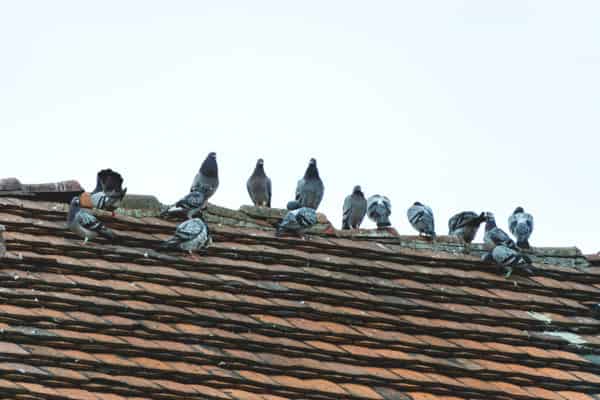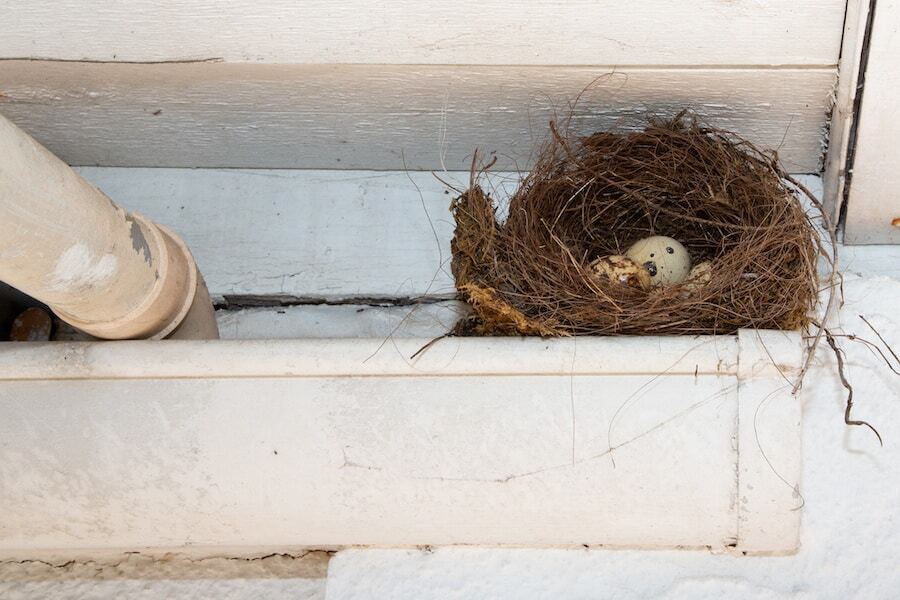READY TO GET STARTED?
REQUEST A FREE ESTIMATE
Fill out the form below or call (888) 466-7849 for a free, no-obligation estimate.

Nesting birds can cause much more damage than one may realize, making bird nest removal a top priority for some homeowners. But why would birds want to build their nests so close to humans? Nesting near, in, or on homes actually provides birds with protection from dangerous predators and helps protect them from extreme temperatures in the environment. Birds will build their nests anywhere that fits the criteria they are looking for. They prefer to nest at higher locations so they can survey the area around them for potential predators while keeping their nests relatively hidden. Bird nests can be found just about anywhere on or around your home. In fact, small birds will even nest in gaps in siding, behind shutters, or even on light fixtures.
So a bird built a nest on your home. Is that bird’s nest dangerous? They can be! Bird droppings contain acid that can corrode metal and concrete and even damage car paint. Debris from nests and bird feathers can clog drains and gutters leading to moisture issues. When nests are built in dryer, fan, or stove vents, they can cause clogs that restrict air flow, cause lint to buildup, and significantly increase the risk of fire. Nests that are built inside attics can cause damage to insulation.
Besides the physical damage to your home, bird nests can also cause health issues for humans. Birds carry pathogens that can be dangerous to the health of you and your family. Nests also contain bird droppings which can carry all sorts of bacteria and other pathogens like histoplasmosis. Nests can also contain parasites, ticks, mites, and other pests that can remain long after birds have vacated a nest.
There are also several federal, regional, and local laws and regulations that restrict or prohibit the relocation, removal, or destruction of bird nests. Without knowing for certain what species of bird has inhabited your home, bird nest removal could be considered illegal and put you at risk for legal ramifications.
The best way to get rid of bird nests is to prevent them from being built in the first place. Here are some steps you can take at home to help prevent birds from nesting in, on, or near your home.
Due to the laws and regulations surrounding bird nest removal and bird protection, it is usually best to call a professional wildlife exclusion company to handle any bird nest issues you may have. These bird control professionals can properly identify the species of bird nesting at your home and properly, humanely, and legally remove it or relocate it from your property.
Which Season is Worst for Bed Bugs?
Pest Control for Businesses: Everything You Need to Know About Commercial Pest Control

Most people may not consider birds when they think of pest control; bird removal does, however, fall into the category of wildlife exclusion. While typically benign to homeowners, birds can be detrimental to both homes and health. Birds can be quite noisy, especially if they build a nest in or on your home. They can cause damage to your roof, car, and property. Their nests can block stove, dryer, and fan vents causing fire hazards and rendering them useless. Their nests can also clog gutters and drains, leading to standing water and potential damage to your roof. Their droppings contain uric acid which can damage the paint on your car. Bird droppings also contain pathogens that are dangerous to humans like histoplasmosis. Bird nests can also contain other pests such as mites, parasites, and ticks that can stick around long after the birds have left the nest.
Birds have been known to build their nests in some very inconvenient places in and around homes. They are often found above doors, over garages, inside sheds, and other high-traffic areas. They can also nest in places that are dangerous to the birds themselves – on top of lawnmowers, heat pumps, etc.
While the decision to remove the bird nest may seem simple, there are Federal laws regarding bird nest removal that make it illegal to remove certain species of birds or their nests. Best practice is always to check with a wildlife control company before attempting to remove any bird nests from your home. If you have verified that the species of bird invading your property is not protected and removal of the nest is legal and necessary, here are some steps to take to ensure both proper and safe removal and/or relocation.
The best way to eliminate bird nests from your property is to prevent them from building in the first place. Remove any food scraps and open trash from around your home as this invites them to feed. Make sure trash is secured tightly in containers. Place any bird feeders and birdbaths away from the home and further out in the yard. Only put out enough food for a few birds and clean up any spills regularly. Consider installing gutter guards to prevent nesting in gutters and downspouts. Vents are a common nesting place for birds so install vent covers and screens. Use perch repellents if necessary; these are rows of bird spikes installed on ledges, window sills, and around the perimeter of the roof to prevent birds from alighting on perches. You can also use visual repellents such as plastic owls, hawks, snakes, and even coyotes. If you use visual repellents, make sure to move them often as the birds will get used to them being in one place. Hang reflective bird diverters from strings on your porch also.
The best time to remove a nest is when it is still in the building stage. If you notice a bird nest already built or remove one this season, keep an eye out in the same area next season and stop it before it is fully completed.
Always make sure a nest is inactive before removing or relocating it. Never attempt to remove or relocate a nest if there are birds or eggs present. It is best to wait until after nesting season for any removal or relocation. Eggs in a nest without signs of the parents don’t necessarily mean the nest has been abandoned. The parents may be out feeding or they may have left to allow the eggs a chance to cool down.
The best time to remove or relocate a nest is after nesting season is over. Most birds only nest once per year; however, some species will nest 4 to 5 times. The time varies with the species of bird. Without knowing the specific species of bird, it is difficult to determine the best time to remove or relocate the nest. A professional can help identify the species you are dealing with and help determine the best time to remove the nest.
Once you have positively identified the species of bird you have, confirmed it is legal to remove the nest, and have made sure the nest is inactive and no eggs are present, you can proceed with removing or relocating the nest. Bird nests can harbor other pests and residual bird droppings that can contain dangerous pathogens for humans. Make sure to wear long sleeves, long pants, latex gloves, and a respiratory mask to protect yourself. Carefully inspect the nest to make sure it is empty of eggs and birds. Spray the nest with an antibacterial spray. Once dry, remove the nest and dispose of it in a securely sealed container or exterior trash bag. Dispose of it in the trash away from the home. Clean the area where the nest was with a strong disinfectant. Remove and dispose of your gloves. Remove your clothing and wash them immediately in hot water. Wash your hands thoroughly.
It can be difficult to determine whether or not the bird nest in or on your home is legal to remove or the best way to remove it. If you have a bird nest that is causing problems in or on your property, contact a professional wildlife exclusion company who can positively identify the species of bird you have, properly remove or dispose of the nest, and help you identify areas where nesting could be a potential issue in the future.
Request a Free Bird Control Estimate
Venomous vs Poisonous Spiders – What’s the Difference?
How Changes To Your Environment Can Help Your Pest Control
Battling a German Roach Infestation